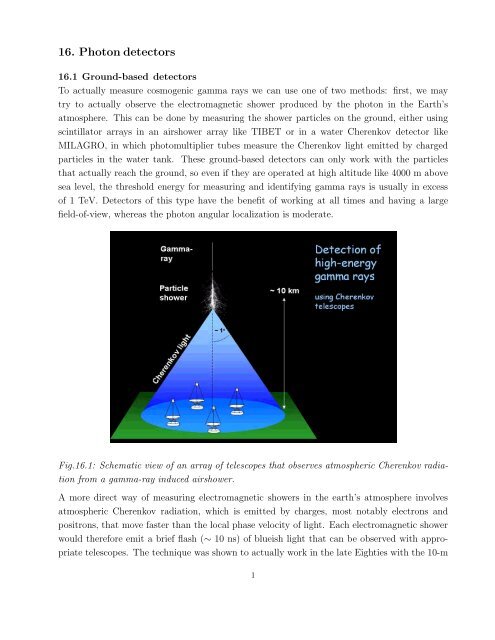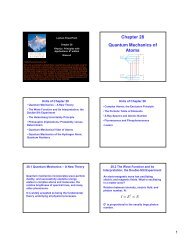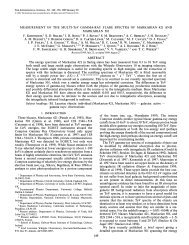Lecture notes - Desy
Lecture notes - Desy
Lecture notes - Desy
You also want an ePaper? Increase the reach of your titles
YUMPU automatically turns print PDFs into web optimized ePapers that Google loves.
16. Photon detectors<br />
16.1 Ground-based detectors<br />
To actually measure cosmogenic gamma rays we can use one of two methods: first, we may<br />
try to actually observe the electromagnetic shower produced by the photon in the Earth’s<br />
atmosphere. This can be done by measuring the shower particles on the ground, either using<br />
scintillator arrays in an airshower array like TIBET or in a water Cherenkov detector like<br />
MILAGRO, in which photomultiplier tubes measure the Cherenkov light emitted by charged<br />
particles in the water tank. These ground-based detectors can only work with the particles<br />
that actually reach the ground, so even if they are operated at high altitude like 4000 m above<br />
sea level, the threshold energy for measuring and identifying gamma rays is usually in excess<br />
of 1 TeV. Detectors of this type have the benefit of working at all times and having a large<br />
field-of-view, whereas the photon angular localization is moderate.<br />
Fig.16.1: Schematic view of an array of telescopes that observes atmospheric Cherenkov radiation<br />
from a gamma-ray induced airshower.<br />
A more direct way of measuring electromagnetic showers in the earth’s atmosphere involves<br />
atmospheric Cherenkov radiation, which is emitted by charges, most notably electrons and<br />
positrons, that move faster than the local phase velocity of light. Each electromagnetic shower<br />
would therefore emit a brief flash (∼ 10 ns) of blueish light that can be observed with appropriate<br />
telescopes. The technique was shown to actually work in the late Eighties with the 10-m<br />
1
telescope at Whipple observatory, and about 70 sources of high-energy gamma-rays have been<br />
detected to date (see http://tevcat.uchicago.edu/). Currently operational observatories that<br />
use this technique involve the H.E.S.S. array in Namibia, the MAGIC telescope of the Canary<br />
Islands, and the VERITAS array in southern Arizona. It should be noted that these telescopes<br />
can only detect gamma rays at energies higher than about 100 GeV, for sufficiently many of<br />
the radiating electrons have to be faster than the phase velocity of light in the atmosphere to<br />
produce a detectable amount of Cherenkov light.<br />
With all techniques a very large effective area can be realized: in the case of an airshower<br />
array one observes all showers that have some shower particles hit the detectors, and therefore<br />
the detection probability is not related to the actual size of the scintillation detectors. In the<br />
case of atmospheric Cherenkov telecopes we only need the telescope located within the light<br />
pool on the ground, which has about 200 m radius. This makes for a geometric area of 10 5 m,<br />
which is also roughly the effective area at about 1 TeV, where the light yield is high enough<br />
to in all cases overcome telescope inefficiencies related to, e.g., the mirror reflectivity or the<br />
PMT quantum efficiency. At lower energies around 200 GeV the effective area is a bit smaller.<br />
The technique works only in clear nights, so only about 10% of the time may be used for<br />
observations. Also the field-of-view is usually small with about 4 degrees diameter. On the<br />
other hand, the single-photon localization is good with about 0.1 ◦ .<br />
The real problem for all ground-based gamma-ray detectors is to distinguish between gammaray<br />
showers and cosmic-ray showers, which can be about 10 5 times as numerous. Cosmic-ray<br />
showers usually involve a large number of pions and are therefore muon-rich, whereas gammaray<br />
showers are muon-poor, but do contain some. Cosmic-ray showers also have particles with<br />
larger transverse momenta and therefore appear wider and more fluffy than gamma-ray showers.<br />
Air shower arrays mainly discriminate hadronic showers via the muon content, which provides<br />
about a factor of 10 in gain, so there are only 10 4 hadronic showers per gamma-ray shower. This<br />
relatively poor background rejection largely offsets the gains arising from the large field-of-view<br />
and the high duty cycle. Atmospheric Cherenkov telecopes reject background by imaging the<br />
shower in Cherenkov light, preferentially by three or more telescopes so a full three-dimensional<br />
image can be derived. Cuts are then applied to select gamma-ray-like events based on the shape<br />
of the showers. The background rate after cuts of contemporaneous atmospheric Cherenkov<br />
telecopes is only about 1 Hz/deg 2 . The Crab nebula, a pulsar-wind nebula and the standard<br />
candle of high-energy gamma-ray astrophysics, produces a rate after cuts of about 0.15 Hz in<br />
the same detector, so it is obvious that a very good background rejection is achieved.<br />
The excellent photon localization allows a further background suppression for point sources,<br />
for which one searches for a peak in rate at the location of the source compared with the quasiuniform<br />
background. Essentially all events associated with the Crab nebula should be recorded<br />
within 0.2 ◦ of its true position, and the background rate in that solid angle element is also only<br />
2
0.1 Hz, so the observed rate would actually more than double and the Crab is detectable with<br />
high statistical confidence of 5σ within 4 minutes.<br />
Fig.16.2: World map with the currently operating or constructed ground-based detectors of<br />
high-energy gamma rays.<br />
16.2 Satellite-based detectors<br />
Lower-energy gamma rays can be measured by placing detectors outside the Earth’s atmosphere<br />
by using balloons or satellites. A common characteristic is that the effective area of these<br />
detectors is small, for interaction must occur within the detector material that has to fit on a<br />
satellite. On the other hand we can control to a certain extent the environment in which those<br />
interactions take place.<br />
In the energy range between about 20 MeV and 100 GeV one uses pair creation on the Coulomb<br />
field of high-Z nuclei such as Tungsten. By measuring the path taken by the electron-positron<br />
pair one can deduce the direction of the incoming gamma ray. In actual experiments one<br />
interleaves thin foils of, say, Tungsten with positionally sensitive charged-particle detectors, for<br />
example silicon-strip detectors, to minimize the amount small-angle scattering on the Coulomb<br />
3
field of the Tungsten nuclei that would change the particle track. Below this detector array<br />
one would place a calorimeter to measure the energy of the electron-positron pair, ideally by<br />
stopping it in the detector. For that purpose the calorimeter has to be thicker than the total<br />
range of the electrons in the detector material. In the Nineties the EGRET experiment used<br />
this technique to observe more than 270 sources of GeV-ish gamma rays. Its successor, Fermi,<br />
has been launched in 2008.<br />
charged-particle<br />
anticoincidence<br />
shield<br />
γ ray<br />
pairconversion<br />
foils<br />
particletracking<br />
detectors<br />
calorimeter<br />
e+ e-<br />
Fig.16.3: Schematic view of a pair creation telescope like GLAST. The detector is embedded in<br />
a shield of scintillators that allow to veto the signals caused by cosmic rays. Position-sensitive<br />
detectors measure the track of an electron-positron pair that has been creation in one of the thin<br />
foils of high-Z material, before the energy is measured in a calorimeter.<br />
To suppress background from cosmic rays entering the detector, the satellite experiments use<br />
an anti-coincidence shield, which is nothing more than an envelope of scintillators that give<br />
a signal when a charged particles enters the instrument. By requiring that any event in the<br />
tracking detector and the calorimeter be not coincident with an signal in the scintillators one<br />
effectively vetoes all background-induced events, so that very weak emission components like<br />
extragalactic diffuse gamma-ray emission can be observed.<br />
The photon localization is compromised by small-angle scattering of the electron or positron<br />
in the tracker material, so essentially by Coulomb scattering and ionization or excitation. The<br />
efficacy of these processes in changing the momentum of an electron falls off with energy, so<br />
the single-photon localization is bad at low energies and good at high energies, where, however,<br />
4
the photons are few.<br />
At energies below 20 MeV one can use Compton scattering to measure gamma-rays. The<br />
detector would consist of two planes and one would require a Compton scattering to happen<br />
in each plane. Generally one measures the energy of the electron on which the photon has<br />
scattered, and the location where the scattering took place. If the gamma-ray is absorped in<br />
the second detector plane, we know the gamma-ray energy after the first scattering in the upper<br />
detector plane. The energy deposited during the first scattering then gives the scattering angle,<br />
so one can reconstruct the arrival direction to a angular ring around the axis connecting the<br />
locations of the two scattering. The photon energy follows from the energy deposited in both<br />
detectors, if one can make the usually correct assumption that the photon doesn’t leave the<br />
lower detector plane. Background arising from activation of detector or satellite material is a<br />
major concern.<br />
Fig.16.4: Schematic view of a Compton telescope like COMPTEL.<br />
At even lower energies below a few MeV one uses solid-state detectors that are equipped with<br />
collimators or coded masks to give some imaging capability. An example is INTEGRAL.<br />
5







